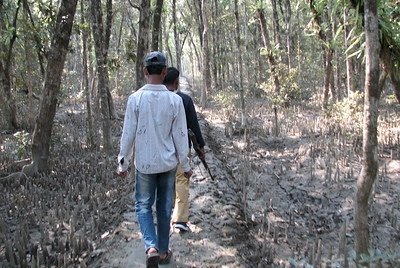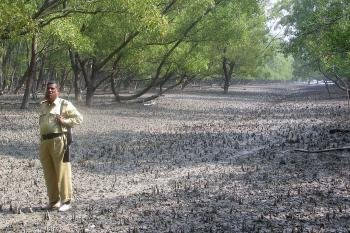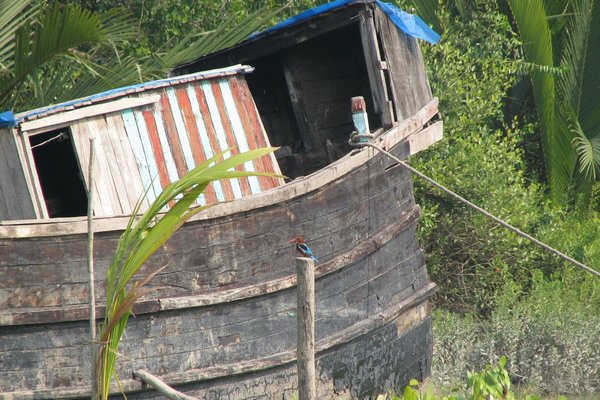Bangladesh
The Sundarbans
The Sundarbans are part of the world’s largest delta and hold among the largest remaining areas of mangroves in the world.
Its ever-changing landscape is fed by three major rivers and shaped by tidal shifts and monsoon rains. The site also has exceptional biodiversity, with a population of about 400 Bengali tigers (the highest density in the world) and over 300 species of birds.
Community Perspective: the park can be reached by boat from Mongla, there are day tours or multi-day trips to choose from. But discount the idea of seeing a tiger! The Indian Sundarbans are inscribed as a separate WHS and no international cooperation seems to exist to merge the two.
Site Info
Official Information
- Full Name
- The Sundarbans (ID: 798)
- Country
- Bangladesh
- Status
-
Inscribed 1997
Site history
History of The Sundarbans
- 1997: Inscribed
- Inscribed
- Type
- Natural
- Criteria
- ix
- x
Links
- UNESCO
- whc.unesco.org
- Related
-
- en.wikipedia.org — Wikipedia
All Links
UNESCO.org
- whc.unesco.org — whc.unesco.org/
Related Resources
- en.wikipedia.org — Wikipedia
News Article
- March 29, 2023 today.rtl.lu — Bangladesh bans plastics in world's largest mangrove forest
- Oct. 2, 2018 dhakatribune.com — The Sundarbans to get four new tourist zones
- Aug. 4, 2018 india.mongabay.com — A cross-border coal plant could put Sundarbans at risk
- May 22, 2017 en.prothom-alo.com — UNESCO recommends placing Sundarbans in danger zone
- Jan. 18, 2017 ecowatch.com — Another Coal Barge Sinks in the Sundarbans
- Oct. 19, 2016 whc.unesco.org — World Heritage Centre and IUCN call for relocation of Rampal power plant, a serious threat to the Sundarbans
- Sept. 12, 2016 thefinancialexpress-bd.com — Shipping dept disagrees with UN over closure of Shela river route in Sundarbans
- March 11, 2016 dailymail.co.uk — Long march in Bangladesh against Sundarbans power plant
- Aug. 10, 2015 foxnews.com — Bangladesh police kill 6 suspected tiger poachers in the world's largest mangrove forest
- Dec. 13, 2014 euronews.com — Oil spill threatens Sundarbans
- Aug. 5, 2013 trust.org — Protests over coal-fired power plant near Sundarbans
- Sept. 10, 2012 thedailystar.net — Experts oppose coal-fired power plant near Sundarbans
- June 23, 2012 gulf-times.com — 400 poachers working for tiger smuggling gang in Sundarbans
- Dec. 16, 2007 english.alarabonline.org — The cyclone that left more than 3,000 people dead in Bangladesh in mid November, also devastated the Sundarbans World Heritage Site, according to UNESCO experts who visited the mangrove forest on the delta of the Ganges, Brahmaputra and Meghna rivers.
- Nov. 21, 2007 news.xinhuanet.com — World's largest mangrove forest in Bangladesh major causality of cyclone
Community Information
- Community Category
- Natural landscape: Rivers, Wetlands and Lakes
Travel Information
Recent Connections
-
Oceanic Dolphins
Irrawaddy and Indopacific Humpback dolp…
-
Golden jackal
This report from the Bangladesh Sundarb…
-
Perfect Inscriptions
1997
Connections of The Sundarbans
- Geography
-
-
River deltas
Ganges-Brahmaputra Delta -
Ganges Basin
shared with Brahmaputra -
Contiguous separate sites across national boundaries
Bangladesh vs India (request for combination by AB ev) -
On National Border
On Bangladesh Border -
Estuary
"Areas of unique natural beauty, ethno botanical interest, special marine faunal interest, rivers, creeks, islands, swamps, estuaries, mud flats, and tidal flats are also included in the property." (Official description) -
Indian Ocean
-
- Trivia
-
-
On Passports
Bangladesh passportSee www.flickr.com
-
Google Doodles
26 March 2020, Bangladesh Independence Day 2020See www.google.com
-
Fatal Accidents or 'disasters'
The Sundarbans has been notorious for its man-eating tigers since the 17th century. Numbers of reported deaths has varied from 0 to 47 (mean = 22.1) per annum during the period 1947-1983 (R.E. Salter, pers. con-m., 1987). In 1988, 65 deaths were reported during a fourmonth period (The Guardian, 28 December 1988). (AB ev)
-
- Ecology
-
-
Tiger habitat
Royal Bengal Tiger -
Mangroves
"Criterion (x): The mangrove ecosystem of the Sundarbans is considered to be unique because of its immensely rich mangrove flora and mangrove-associated fauna. Some 78 species of mangroves have been recorded in the area making it the richest mangrove forest in the world." (OUV) -
Crocodiles
-
Otters
Indian otter -
River Dolphins
South Asian River Dolphin (Ganges sub-species) Other mammals include .... (the) Ganges River Dolphin Platanista gangetica (EN), which occurs in some of the larger waterways" (AB). The Irrawaddy Dolphin is also fund but "although sometimes called the Irrawaddy river dolphin, it is not a true river dolphin but an oceanic dolphin that lives in brackish water near coasts, river mouths and in estuaries. It has established subpopulations in freshwater rivers, including the Ganges" (Wiki) -
Tidal effects
The landscape is dynamic, constantly moulded and altered by tidal action (UNEP-WCMC) -
Dunes
easily eroded sands collect at the river mouths forming banks which are blown into dunes (UNEP-WCMC) -
Critically endangered fauna species
Northern River terrapin (UNEP-WCMC) (about 100 remaining) -
Swamps and Marshes
" Areas of unique natural beauty, ..., swamps, .. are also included in the property. " (OUV) -
Bird Migrations
The African-Eurasian Flyway -
Orchids
"Its exceptional biodiversity is expressed in a wide range of flora; 334 plant species... and 13 orchid species" (OUV) -
Eagles
White-bellied sea eagle (Official description) -
Molluscs
Crit x: "43 mollusks species" -
Over 300 bird species
315 (IUCN Outlook 2017) -
Mudflats
"mud flats, and tidal flats are also included in the property" (integrity statement) -
Mudflats
"The Sunderban mudflats are found at the estuary and on the deltaic islands where low velocity of river and tidal current occurs" (wiki)See en.wikipedia.org
-
Golden jackal
This report from the Bangladesh Sundarbans lists the Jackal among the mammals
-
Oceanic Dolphins
Irrawaddy and Indopacific Humpback dolphins (UNEP-WCMC)
-
Turtles and tortoises
River terrapin (UNEP-WCMC)
See en.wikipedia.org
-
- Damaged
-
-
'Threatened' by Dams
sediment flow changes due to existing dams have stunted the growth of the Sundarbans -
Oil Spill
small coastal oil tanker sank after being rammed by another vessel from behind, releasing approximately 400,000 liters of oil in the water (2014)See whc.unesco.org
-
- World Heritage Process
-
-
Perfect Inscriptions
1997 -
Recommended for combination by AB
As the adjacent Sundarbans National Park in India is already inscribed on the World Heritage List, the authorities in both countries should be encouraged to agree to the joint listing of the site as a transfiontier World Heritage property. (AB ev)
-
- Human Activity
-
-
Honey Collection
Honey and wax collectors enter the Sundarbans to access nests and collect these non timber forest products, with permits from the Forest Department (IUCN Outlook 2017)
-
- WHS on Other Lists
-
-
Ramsar Wetlands
Sundarbans Reserved Forest, 1992 -
WWF Global 200
Terrestrial, Mangroves: (139) Sundarbans MangrovesSee web.archive.org
-
World Heritage Forest Programme
-
Centres of Plant Diversity
IS10 Sundarbans - "Its exceptional biodiversity is expressed in a wide range of flora; 334 plant species belonging to 245 genera and 75 families"
-
- Timeline
-
-
Holocene
The tract of the Sundarbans is of recent origin, raised by the deposition of sediments formed due to soil erosion in the Himalayas. The substratum consists mainly of Quaternary Era sediments, sand and silt mixed with marine salt deposits and clay. Geologists have detected a southeastern slope and tilting of the Bengal basin during the Tertiary. Because of neo-tectonic movements during the 10th-12th century AD, the Bengal Basin titled eastward. Evidence from borehole studies indicate that while the westernside of the Sundarbans is relatively stable, the southeastern corner is an active sedimentary area and is subsiding. (link)
-
- WHS Names
-
-
Misleading WHS Names
This only includes the Bangladeshi side of the area, and focuses on the mangroves. A better name, as suggested by IUCN in its evaluation, could have been 'The Sundarbans Mangrove Reserves of Bangladesh'. -
Named after a Tree Species
Sundari tree, a special kind of mangrove tree.See en.wikipedia.org
-
News
- today.rtl.lu 03/29/2023
- Bangladesh bans plastics in world'…
- dhakatribune.com 10/02/2018
- The Sundarbans to get four new tou…
- india.mongabay.com 08/04/2018
- A cross-border coal plant could pu…
Recent Visitors
Visitors of The Sundarbans
- A. Mehmet Haksever
- Ammon Watkins
- Atila Ege
- Bill Maurmann
- Bram de Bruin
- Christravelblog
- Dimitar Krastev
- DouglasR
- Els Slots
- fedemarch92
- Harry Mitsidis
- Iain Jackson
- Kjlauer
- Kurt Lauer
- Loic Pedras
- Luis Filipe Gaspar
- marcel staron
- Mikko
- Monica66
- Philipp Leu
- Roger Ourset
- Roman Bruehwiler
- Solivagant
- Stanislaw Warwas
- Szucs Tamas
- Thomas Buechler
- Timothy C Easton
- Truls Brekke
- Vanessa Buechler
- Weecheng
- Zhou Yan
- Zoë Sheng
Community Reviews
Show full reviews
The Sundarbans are the closest thing to a tourist attraction Bangladesh has. I took a one-day boat trip to the newly established visitor center at Harbaria. You'll have to spend several days to get really deep into this large park, but to me this trip was fine.
We first sailed (on a small motorboat) along the coastline, thickly covered with forests. We saw a number of kingfishers, some dolphins, and a crocodile on our way. We would have liked to see a Bengal tiger of course, but they are rare. My guide and the boatmen had seen one here in November 2006, not far from Mongla town.
After 4 hours we arrived in Harbaria, where we did get ashore. We were assigned a man with a gun. Together we walked the trail that has been laid out here that lets one get the feeling of being in the 'real jungle'. Having a man walking in front of you with a gun really helps to get a spooky atmosphere (maybe the tiger is looking at us from behind the trees). If it's really that dangerous, it would help to have a man with a gun walking behind us too. The highlight was seeing tiger footprints, left in the mud sometime before.
Keep reading 0 comments
The Sundarbans are badged as “The largest mangrove belt in the world, the habitat of the famous Bengal tiger...” In order to visit them you will need to go by boat, but how exactly you achieve this will depend on why you are going! If you just want to get a quick feel for the forest/mangroves and to tick off another WHS, a short trip to the nearest Forest Station in the park can be arranged by local boat on arrival at Mongla, a few miles north of the park boundary and reachable by bus from Khulna (the 3rd largest town in Bangladesh). There you can disembark, pay the forest fee and do a short walk with a guide and be back to Khulna inside a day.
There are however a number of “cruise boats” offering trips through the Sundarbans and out to the Bay of Bengal lasting several nights. We chose (and arranged via their Web site) a 3 night trip operated by a company called “The Guide Tours”. I can’t of course state that they are the best but they did everything they promised and provided a “clean” well run ship (They operate 3 and ours had 6 cabins with 12 bunks) with reasonable food and pleasant “public areas”, an English speaking guide with good wild life knowledge and a couple of excursions each day either by boat (a local craft rowed from the stern – important to maintain silence) or on foot (with gun toting park staff …
Keep reading 0 comments
